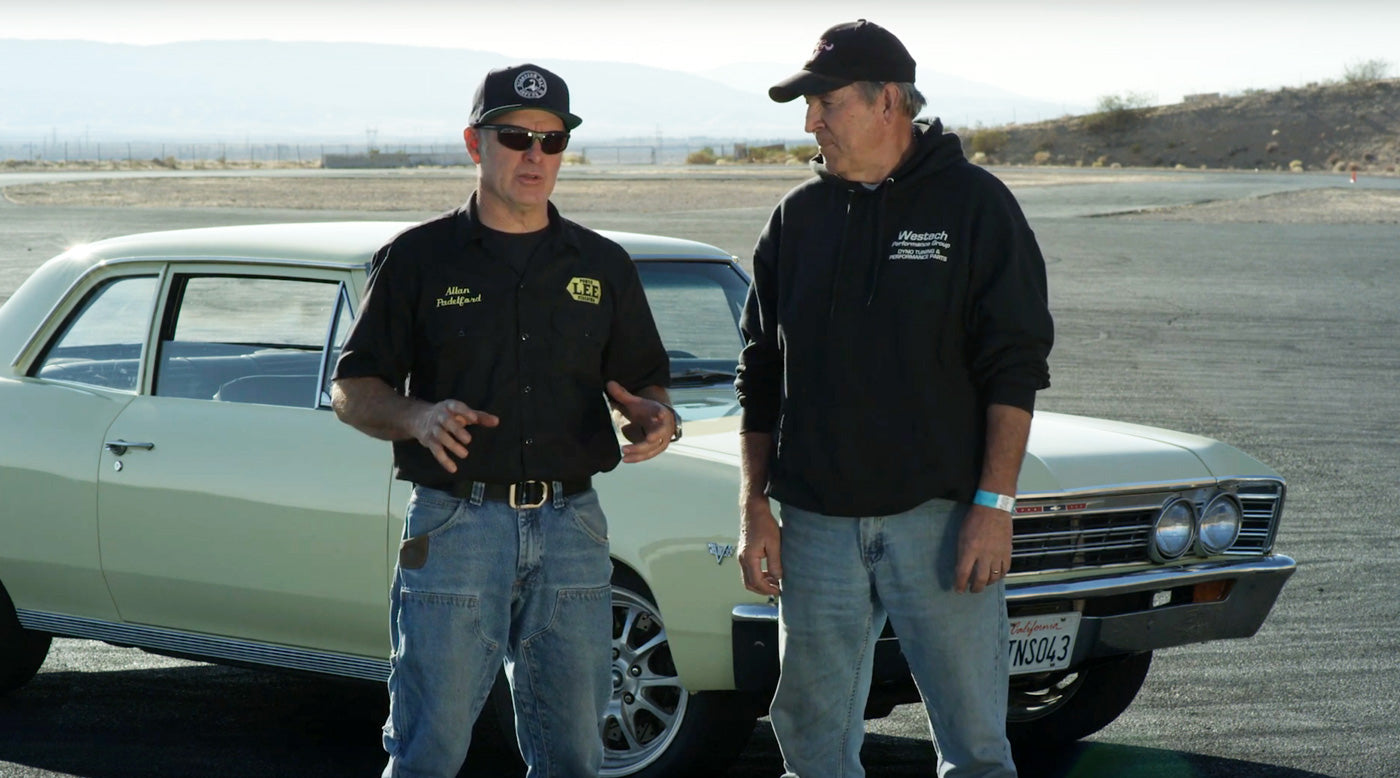Power Steering Gearbox Ratio Road Testing with Jeff Smith, Part 2

Part 2 of our video series where Allan Padelford discusses power steering gear box ratios & steering efforts with Jeff Smith, former Editor of Hot Rod Magazine and current freelance writer.
Products Used In This Video
Allan Padelford [AP]: Here we are out at the test track now, and we've laid out a course for Jeff to run through with his car. He'll be able to feel the power steering ratio difference, obviously, and then also the feel of the car.
Jeff Smith [JS]: We'll be doing a bunch of different boxes. We'll do three different boxes?
AP: Right. We're going to start with your 12:1, All we did was clean it up, get the dirty oil out of it, so it doesn't contaminate the other boxes when we switch them out. We'll use your original 12:1 gearbox, that has a light feel to it that you didn't like. Then, we'll switch to our 12:1 gearbox with a 35 pound valve. After that, we've got a 16:1 variable gearbox, which is our standard hot rod steering ratio for just cruising around. After that, we'll go, we'll try our racing 9:1 gearbox.
JS: 9:1 - that sounds like fun.
AP: You bet. Here we are in the first slalom. That's just about maximum for that feel of the wheel.
JS: Yeah, it is. The big thing is, it's fast, but there's no feel to it whatsoever. You could almost do it with one finger.
AP: Couldn't do that around here, around this one little spot here.
JS: Okay. This is nothing. I'm doing one finger.
AP: Yeah.
JS: And you feel it here, too, there's no return to it. In terms of you're not getting anything fed back through the wheel. It seems odd, but a little bit more resistance is better. It's there. It's fast. But, there's…
AP: You need some feedback from the suspension.
JS: Exactly.
AP: Literally, little or no effort on the wheel.
JS: Almost none.
AP: Let's take her in and put in a 12:1 gearbox with a 35 pound valve. We've swapped out the box to one of our new 12.7:1 with a 35 pound valve. What do you think, Jeff?
JS: There is a difference. It feels like a completely different steering box, even though the ratio is still the same. The efforts gone way up, which it sounds weird, but it gives you more control. At low speeds there's quite a bit more effort, then with additional speed, it's not as noticeable, but it's still much better. It's just a much better feel. It inspires more confidence. It just feels better.
AP: I can tell you feel better about it.
JS: Oh, yeah. It's a lot more fun. When you think about it, when you're driving a car this is what you're touching all the time.
AP: That's your feedback.
JS: Yeah. Its instant feedback all the time. You want to talk about something that makes a difference in the way you drive your car, this is it. It's an amazing difference.
AP: Let's take her in and we're going to put a 16:1 variable steering gearbox with a 35 pound valve. It'll have the same feel, it's just an easier ratio to get. It's probably the most popular ratio that the company makes. It comes in trucks, and it's come in a lot of vehicles that were made past the 80s.
JS: Okay.
AP: Here we go in the 16:1 variable. 35 pound valve. So same valving as our 12:1. For an everyday guy that's just tooling around, probably a pretty good choice.
JS: Oh yeah - this is a great.
AP: Definite improvement over the 17:1 that it came with.
JS: Absolutely.
AP: Generally speaking, for an average hot rod, the 16:1 would be fine.
JS: Oh yeah.
AP: All right. Let's take her in.
JS: That was fun. Now, it really gets fun.
AP: Yeah. You're going to notice a big, big difference now. Here we are going out on the track with a 9:1 gearbox. And he's already smiling.
JS: Yeah. Already smiling. That's amazing.
AP: Valve weight is the same. The steering efforts the same.
JS: Effort, yeah the same. Now the response is so much quicker. It's like here before I had to really wheel it over. Boom. Wow. That, right there, is probably the biggest part. Yeah, it's an amazing difference. And then, from the original box to this one, it's just huge difference. It's amazing how it makes the whole car feel different. The whole car feels different.
AP: It feels like a sports car. For auto cross, where you've got a lot of tight turns, this would really be helpful. This is where the gear ratio change was a big difference.
JS: Yes. Yes.
AP: All right. Let's take it out on the road, and see how it feels on the highway.
AP: Yeah, let's see how it feels on the highway. All right, we're cruising down the highway with a 9:1 steering ratio. Jeff, what do you think?
JS: Oh, it's fantastic. You would think that it might be twitchy on the road, but it really isn't. It's nice and stable, and it's not like I really have to pay attention to it. We can sit here and talk and I don't have to really concentrate. But yet, if you make a lane change, boom, it's there.
AP: Right. Let's head back to the track and talk about what we've accomplished today. What did we learn about the valve and being the most important?
JS: The valving really has a much more effect on the feel of the steering rather than necessarily the ratio. The ratio, when you get down to the nine, it definitely makes it quicker. The difference between 16 and 12, really the valve is what did it.
AP: Right. I was actually even surprised how little difference the 16:1 variable was to the 12.7:1.
JS: It's almost imperceptible.
AP: Noticeable to a driver that drives all the time. But, to the…
JS: Pro-driver would probably notice it. I don't consider myself a pro-driver.
AP: The 9:1, that really put the smile on your face.
JS: Oh, boy. That was a lot of fun. I could have done 50 more laps. It was how much you had to change the way you drive because now it reacts so quickly, it actually ... I could actually delay my turning point, which theoretically should be quicker.
AP: Yeah. Made that big hunk of iron feel like a sports car.
JS: This thing does not feel like a Chevelle now. It's amazing how just the change ... I've done a lot of stuff over the years, a lot of different things we've done on power and handling and braking, and all those other things. This is one of the most dramatic changes I've ever seen in a car for one quick change like that.
AP: All right.
JS: That was amazing stuff.
AP: We did take a little tool out on the road and it felt pretty good.
JS: It did. And you would think maybe it's going to hunt around or be twitchy, but it really wasn't. You have to pay attention, because if you change lanes, if you touch the wheel, it's going to start moving. It's not something that you couldn't deal with. It's a lot of fun.
AP: Not something we would recommend for the street?
JS: No. You have to pay attention. You do have to pay attention. It happens so much more quickly. Especially if you think you're driving some big boxy 60s car.
AP: Exactly. Right. Fair enough.
JS: Lot of fun, thank you.
AP: Thank you very much.
» More Blog Posts
